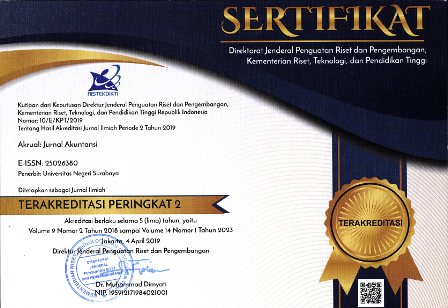Dynamic Capabilities and Hospital Performance: Perception Study of the NU Hospital Directors in East Java
DOI:
https://doi.org/10.26740/jaj.v14n2.p176-190Keywords:
dynamic capabilities, entrepreneurial orientation, financial resources, hospital performance, information technologyAbstract
There is a lot of empirical evidence regarding the effect of financial resources, entrepreneurial orientation, and information technology on dynamic capabilities and firm performance. So it is necessary to reconcile these findings. The analytical tool used in this research is (SmartPLS) version 3.0. Population in this study are individuals who work, have leadership-level positions or are directors of NU hospitals in East Java. The number of NU hospitals in the East Java region is 22 hospitals. The sample size obtained is a minimum of 57 individuals. The results of this study are financial resources are empirically proven to have a direct effect on dynamic capabilities, and financial resources also have an indirect influence on hospital performance through dynamic capabilities, entrepreneurial orientation is empirically proven to have a direct effect on dynamic capabilities, and entrepreneurial orientation on hospital performance. Through dynamic capabilities, financial resources have not been empirically proven to have a direct effect on dynamic capabilities, dynamic capabilities do not mediate the relationship between financial resources and hospital performance, and dynamic capabilities have a direct effect on hospital performance
References
Azwir Nasir, A. O. R. (2011). The Effect of Technology Utilization and Internal Control on the Performance of Government Agencies. Journal of Economics, 9. https://doi.org/http://dx.doi.org/10.31258/je.19.02.p.%25p
Baban Sobandi. (2006). Effect of company response in information technology investment on company performance: business strategy, information technology maturity, and company size as antecedent variables. Faculty of Economics, University of Eleven March.
Dosi, G., & Teece, D. J. (1994). Preface: Dynamic capabilities. Industrial and Corporate Change, 3(3), 537. https://doi.org/10.1093/icc/3.3.537
Fainshmidt, S., Wenger, L., Pezeshkan, A., & Mallon, M. (2018). When do Dynamic Capabilities Lead to Competitive Advantage? The Importance of Strategic Fit. Journal of Management Studies. https://doi.org/https://doi.org/10.1111/joms.12415
Gaspersz, V. (2003). Performance Management System integrated Balance Scorecard with Six Sigma for business and government organizations. PT. Gramedia Main Library.
Hasibuan, H. (2010). No Title. The Effect of the Application of Financial Accountability, Compliance with Laws and Regulations and Organizational Culture on the Performance Accountability of Government Agencies , a Study on SKPD in the City of Pekanbaru. https://doi.org/undergraduate thesis, Faculty of Economics, Riau University.
Khin, S., & Ho, T. C. (2018). Digital technology, digital capability and organizational performance. International Journal of Innovation Science. https://doi.org/https://doi.org/10.1108/IJIS-08-2018-0083
Limakrisna, N., A. Sudarso, et al. (2015). Entrepreneurship Orientation for Building Business Performance: An Empirical Study Distro Small Medium Enterprises Bandung City. AFAP International Cenference on Entreprenuerial and Business Manage., 2. https://doi.org/https://dergipark.org.tr/en/pub/ijefi/issue/31972/352272
Mckeen, J. & Smith, H. (2008). IT strategy in action. Prentice Hall, New Jersey: Pearson.
McKelvie, A., & Davidsson, P. (2009). From resource base to dynamic capabilities: An investigation of new firms. British Journal of Management, 20(SUPP. 1). https://doi.org/10.1111/j.1467-8551.2008.00613.x
Rabbil , MZ, Yasmine, NS, and Comm, M. (2017). Analysis of effects of environmental dynamism, entrepreneurial orientation, and dynamic capability on the performance of SMEs. International Journal of Humanities and Management Sciences, 1(5).
Rahmadini. (2015). Comparative Analysis of Performance Achievements of PPK-BLUD RSUD Permenkes Number: 209/SK/I/2011 Versus Perdirjen Treasury Number: Per-34/PB/2014.
Downloads
Published
How to Cite
Issue
Section
License
Copyright (c) 2023 Saiful Anam, Soegeng Sutejo, Muhammad Nafik Hadi Ryandono

This work is licensed under a Creative Commons Attribution-NonCommercial 4.0 International License.
 Abstract views: 369
,
Abstract views: 369
, PDF Downloads: 433
PDF Downloads: 433

















